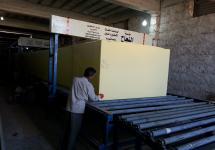The beneficial properties of cottage cheese (the presence of calcium salts, balanced protein, the ability to digest quickly) allowed him to take an important place in the human diet. The production of cottage cheese attracts many businessmen due to its relevance, lack of complexity. Such a business can be developed in different volumes, starting with the smallest ones.
Cottage cheese is a fermented milk protein product (fatty, semi-fat, fat-free) with a delicate taste. It has a positive effect on the gastrointestinal and cardiovascular systems of the body.
It has a number of healing properties:
- prevention of atherosclerosis due to the content of methionine and choline;
- prevention of liver diseases due to the content of amino acids;
- protection against atherosclerosis due to the content of B vitamins;
- strengthening of bone tissue due to the content of calcium and phosphorus;
- normalization of the nervous system, metabolism.
The organization of production and marketing of products can be established at home. To do this, it is enough to have milk, sour cream, dishes and a small room (it can be a kitchen) available.

The tasks become somewhat more complicated when the business is enlarged. An increase in space, investments, time, documentation is required. But the income also increases accordingly.
Curd manufacturing technology
In the manufacture of the product, it is important to comply with technological standards. The raw material is cow's milk. The production is based on the ability to coagulate the protein under the influence of introduced starter cultures. There are different ways to produce this product.
It is based on fermentation of dairy products by bacteria. The final product is defatted. For the production of this method, good quality milk is used up to 20 degrees Turner (°T).
Degree Turner - the amount of ml 0.1n. sodium hydroxide (or potassium) solution needed to neutralize 100 ml of milk. Turner degrees measure the acidity of milk to evaluate its freshness and naturalness. High-quality milk is characterized by indicators of 16-20 ° T., and a product with higher rates is considered off-grade.
Preparation for fermentation includes the following steps:
- Normalization of the fat composition of milk (standard ratio of fat and protein, corresponding to the expected composition of the cottage cheese). Milk is normalized by mixing with a product of a different fat content (skim, cream) or by separation.
- The fight against mechanical impurities (particles of feed, bedding, hair). The simplest way is filtration using gauze, synthetic fabric or non-woven material. More reliable is the centrifugal cleaning method by means of separators-milk cleaners.
- Pasteurization. It is heating to a temperature of 78 ° C for 30 minutes to get rid of germs.
- Cooling to the desired temperature (28-32 degrees).

Fermentation of cottage cheese is carried out in special baths in the following sequence:
- the introduction of a special rennet enzyme, necessary for coagulation of milk, as well as calcium chloride for the fermentation process;
- actually, the fermentation process;
- cutting the clot into cubes along the edge of 2 cm with a wire knife, independent separation of whey;
- self-pressing when moving from the bath to the bags;
- forced pressing for the final removal of whey;
- cooling to stop lactic acid fermentation up to 4-8 degrees in the refrigerator or when using a special cooler;
- packaging in bars of different weights, automatic or semi-automatic;
- storage in refrigerators until sale.
This method has a number of disadvantages:
- the method is based on manual labor;
- the process is quite long (up to 12 hours);
- a lot of fat is removed from the clot along with the whey;
- the method is open, not completely protected from the entry of microorganisms.
By the way a clot is formed, acid methods are distinguished (using lactic acid fermentation), rennet acid (accelerated as a result of the introduction of rennet and calcium chloride).
A clot is an elastic formation of curdled milk.
Production of cottage cheese by acid-rennet method
The acid-rennet method is based on the formation of a clot of medium and high fat content, which is provided by rennet and lactic acid. With this method, leaven from 1 to 5% is introduced into the cooled mixture. It is made using lactic acid streptococcus. These are bacteria that cause lactic acid fermentation. Sourdough can be made in special microbiological laboratories and biofactories.
Next, rennet or pepsin is added, prepared in about 6 hours in boiled 35-degree water. This enzyme activates the separation of whey from protein components, acting as a catalyst for the production of cottage cheese.

For 3 hours after the start of fermentation, the milk should be stirred at intervals of half an hour. This is necessary to prevent the settling of fat.
Determination of the degree of readiness (break test)
The end of the spatula should be inserted into the clot at an angle, carefully lifted.
Result:
- The kink is even, its edges are shiny, a transparent light green serum stands out - the clot is ready.
- The fracture is flabby, watery, the serum is cloudy - the clot is not yet ready.
The acidity of the finished clot is 58-60°T. The process takes approximately 6-8 hours. To reduce the fermentation time to 4-5 hours, the temperature rises to 35-37 °.
In addition to the curd itself, the clot contains moisture with whey proteins. It accounts for about 70%. To remove it, the clot is divided into parts, for which wire knives are used. The resulting cubes are left for half an hour to remove the remaining whey.
The method was introduced for the first time in Chelyabinsk in 1961. The basis is the production of low-fat cottage cheese, followed by the addition of cream to increase the fat content to the desired percentage (9-18). The method provides accelerated whey separation while reducing losses. All calculations are performed using the developed tables.
The method has many advantages:
- Reduced fat loss.
- The process is completely mechanized. Special separators are used to separate the curd.
- Special production lines have been developed and mechanized, where milk is pasteurized, cooled, fermented for 8-10 hours in containers with mixers.
Acidity with this method reaches 95-100°T. The clot is fed into the heat exchanger, where it undergoes heat treatment. This contributes to the separation of serum, the destruction of microorganisms.
Then, with the help of a pump, the clot is fed into the separator to separate the curd from the existing whey. It is removed, the curd is discharged into the receiver.
Chilled cottage cheese is fed into the mixer for mixing with cream in the required proportions. Further, the cottage cheese is automatically packaged. This is a mild dietary product.

Making thermostatic curd
With the thermostatic method, already fermented milk is poured into packages. The packages are moved to thermostatic chambers, and the whole process of curd preparation takes place inside the package.
The temperature required for ripening is maintained inside the chamber. The cost of the product is reduced, the productivity is correspondingly increased.

How fat-free cottage cheese is made in production
Fat-free cottage cheese is considered to be with a minimum content of fat in its composition: 0.1-1.9%. The technology of its production is based on achieving such percentages. The basis of its production is low-fat milk. Therefore, the separation of milk can become the initial stage of production.
Then one of the methods of fermentation is applied. From skimmed milk, the same product is obtained, to which, if necessary, the necessary amount of cream can be added to achieve the desired percentage of fat content.
How grained cottage cheese is made in production
One type of low-fat cottage cheese is grained. This product is made from cottage cheese raw materials with the addition of table salt and cream. There is no heat treatment. Consistency stabilizers (food additives) are not added. After all, they prevent the separation of whey, improving the viscosity of the product, which is not necessary in the case of the manufacture of grain mass.

Technological scheme of cottage cheese production
The curd product is produced in stages:

Storage at temperatures up to 8 ° should not exceed 36 hours.
Documentation of the curd business
Permission to conduct business for the production of cottage cheese is issued by executive authorities (city state administration, district state administration). The following steps are required to set up a business:
- The choice of the form of organization of production: LLC, IP. If the scale of the planned production is not large, then it makes sense to choose an IP. Registering it is much cheaper and easier.
- Selection of the OKVED code - 15.51.14 "Production of cottage cheese and cheese-curd products".
- Room selection.
- Obtaining permits from SES and fire inspection. Submit the following documents to these authorities:
- on state registration (copy);
- on the lease of premises (space);
- list of equipment, list of employees;
- taxpayer certificate (copy);
- production flow chart;
- passport for the ventilation system;
- disinfection agreement.
The right to production activity is confirmed by a license. To purchase it, you should prepare documents for the State Food and Beverage Industry:
- statement;
- copies of the requested constituent documents;
- receipt of paid state duty.
- After studying the production workshops, a permit for production activities is issued for a period of 5 years.
- Product certification. It is carried out after the release of the test batch. This document confirms the safety and quality.
Required documents for certification:
- statement;
- founding documentation;
- Contract;
- label samples;
- veterinary certificate;
- registration certificate.
Assistance in certification matters can be provided by a specialized intermediary company.
Products must comply with GOSTs. All manufacturers of curd products in their work must be guided by the adopted "Technical Regulations for Milk and Dairy Products".
SES, fire inspection, other bodies control, including:
- sanitary and hygienic regime;
- maintenance of equipment, inventory;
- medical examinations of employees.
Production control provides monitoring of product quality and safety indicators.
Production of cottage cheese in mini-factories
For effective business development and optimal profit, it is important to rationally use financial investments and use reliable equipment with the involvement of highly qualified personnel. This is feasible when choosing such a form of production as mini-factories. The development of the project will cost about 70 thousand rubles. For the total investment in the mini-factory, approximately 5.5 million rubles will be needed. Given the stability of work, this amount will pay off in at least 2 years.

All-Russian classifier of types of economic activity (OKVED) for the production of cottage cheese and cheese-curd products: 15.51.14. The necessary documents are issued in the fire and sanitary-epidemiological inspection.
Premises for the organization of production
The following requirements are imposed on the premises (leased or owned):
- having at least 30 sq. m. area for the main workshop;
- the availability of the possibility to create a laboratory with the necessary quality control devices;
- mandatory systems: electricity, water supply, sewerage;
- equipment for ventilation and heating systems;
- implementation of sanitary standards, means for protection against rodents, cockroaches;
- tiled wall covering at least 2 meters high;
- light color schemes of the walls;
- the flooring is waterproof, acid-resistant, non-slippery;
- equipping with the necessary technological equipment;
- compliance with environmental regulations.

All requirements are covered in SanPiN.
Production staff
For the production of a product at a mini-factory, a staff of 3-4 to 8-10 people is enough.
Approximate required specialties:
- workers;
- technologist;
- laboratory assistant;
- accountant;
- sales manager.
The need for a particular specialist is determined by the volume of production. A laboratory assistant, for example, is needed to determine the quality of raw materials and finished products, to monitor sanitary and hygienic parameters. All employees undergo training, medical examination, hygiene training.
Curd making equipment
The following set of equipment is required for the production of cottage cheese:
| Type of equipment | Purpose |
|---|---|
| tanks | Milk storage |
| Separator | Separation of cream from milk |
| Baths | Fermentation process, pasteurization |
| Wire knives | Clot cutting |
| Press trolley | Product pressing |
| Refrigerators | Cooling of the manufactured product |
| Filling machine | Dosage, packaging, labeling |
| Other auxiliary elements | Piping, pumps, coolers… |
There are special automated lines that carry out the entire production process. The mechanization of the process allows you to attract a minimum of labor (2-3 people) and, accordingly, save money.
The mini-plant allows for the automation of the technological process, reducing the labor intensity and cost of production.

How to organize the supply of raw materials for the production of cottage cheese
The raw material for cottage cheese is natural milk of high quality and varying degrees of fat content. If you have your own raw material base, the efficiency of production increases. Farmers can become permanent suppliers of milk.
Benefits of working with farmers:
- reduction of costs for the delivery of raw materials with the territorial choice of nearby farms for permanent cooperation;
- product quality assurance, confirmed by the certificate of the local veterinary station.
The organization of raw materials supply includes:
- search for a counterparty - supplier;
- conclusion of a supply agreement with him.
The contract must include:
- purchase price;
- product quality parameters;
- frequency, timeliness of deliveries;
- conditions for the return of products, deferred payments;
- conditions for terminating the contract.
When choosing a supplier, consider the following criteria:
- the quality of the supplied raw materials;
- comparative analysis of prices;
- reputation of the supplier;
- optimal location.

Acceptance of raw materials is carried out according to the invoice in the presence of a quality certificate.
To increase production volumes with a decrease in the cost of production, the production of cottage cheese from powdered milk (whole and skimmed) is practiced. This allows you to reduce milk deficiency during the off-season. Appropriate technologies have been developed.
Distribution channels for finished products
In order to have regular buyers of finished products, it is important to take the following steps: advertising the product, improving packaging, packing different volumes, and diversifying the assortment. It is optimal to find wholesale buyers.
Systematic promotions and a system of discounts contribute to the establishment of sales. Effective is cooperation with retail chains (shops, cafes), opening their own outlets.

Business profitability
The cottage cheese business is always profitable, which is explained by the demand for products. The production of cottage cheese is cost-effective and pays off quickly. However, at the start, financial investments will be required. On average, with an investment of 4.3 million rubles. and the production of cottage cheese in volumes of 90 kg / hour, investments will pay off in 19-25 months. The profitability of production as a whole is 7-10%.
The main advantages of the curd business:
- demand for the product in the market;
- ease of production technology;
- availability of raw materials and equipment;
- in case of difficulties in registration, it is possible to attract specialists.
When organizing your own business, it is important to consider the following points:
- the need for financial investments at the start;
- the importance of establishing contact with suppliers of raw materials and consumers of products;
- with large volumes of production, the importance of involving a professional technologist and other specialists in cooperation.
The annual increase in the range of curd products, its demand among the population opens up new niches for business development in this direction: expansion of production volumes, product lines. For example, adding curd mass, curds, creams, cakes. Production of semi-finished products: cheesecakes, dumplings, etc.


